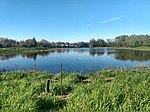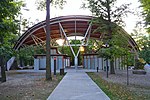TAAG Park

TAAG Park is a FieldTurf stadium located at Carleton University in Ottawa, Ontario, Canada, on the north-eastern edge of the university campus, where Bronson Avenue meets University Road. The stadium was renamed TAAG Park in August 2022.Known as Raven Field until 1998 when it became known as Keith Harris Stadium. Keith Harris served as the Director of Carleton Athletics for over 30 years and was inducted into its Hall of Fame in 2000. In 2011, the Carleton Board of Governors approved a plan for the expansion and renovation of the stadium.The stadium is home to Carleton University Ravens varsity football team, men's and women's varsity soccer teams and women's rugby team. The stadium, supplied and installed by Sport Systems Canada Inc, has a seating capacity of 3,044, plus room for approximately 500 spectators on the "Perch", a hill on the east side of the stadium often used by students, for a total capacity of 3,500. Also, there are three state of the art press boxes complete with viewing platforms.
Excerpt from the Wikipedia article TAAG Park (License: CC BY-SA 3.0, Authors, Images).TAAG Park
Colonel By Drive, (Old) Ottawa Capital
Geographical coordinates (GPS) Address External links Nearby Places Show on map
Geographical coordinates (GPS)
| Latitude | Longitude |
|---|---|
| N 45.388611111111 ° | E -75.694166666667 ° |
Address
MNP Park
Colonel By Drive 1125
K1S 2R2 (Old) Ottawa, Capital
Ontario, Canada
Open on Google Maps








